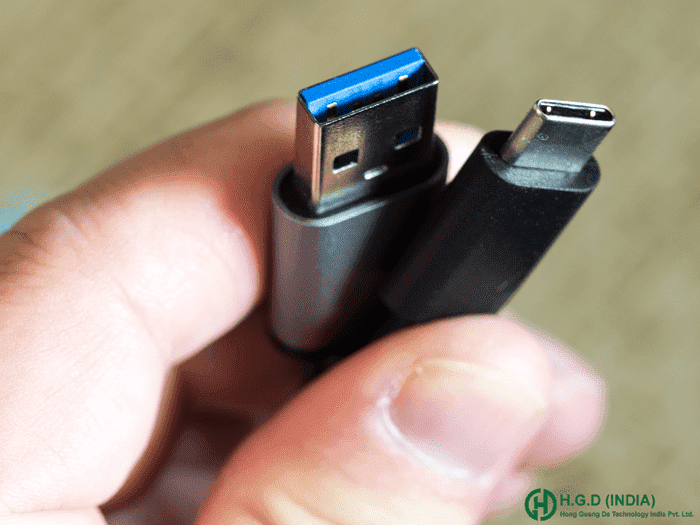What’s the difference between USB-A vs. USB-C ?

Ports are more confusing than should need to be. With all the different USB standards out there, it’s easy to get overwhelmed by the amount of options.
USB-A and USB-C are the two most common forms of USB, and knowing the difference between the two is important for knowing what all your devices and peripherals can really do.
What is USB-A?
USB “Type A” connections refer to the physical design of the USB port. Every USB connection is made of a port in the host device, a connecting cable, and a receptor device. USB-A is a traditional USB host port design and one of the easiest to recognize on devices.
It’s a horizontal port with the “bottom” portion dedicated to pin connectors. This creates the infamous one-sided USB connection that only works when the cable is inserted the correct way, no matter how many times you have to try.
Interestingly, there is no USB-B host port. The USB-B design is the receptor port located on the devices you are connecting to the host computer. Type B connections are also easy to recognize because they are squarish designs, almost like the shape of a little house. If you look at a Type A cable, you’ll see the Type A connection at one end and the Type B connection at the other.
Note that there are also subsets of this design like USB Mini A and USB Micro A that have different port designs, but these aren’t as important for our current discussion.
What is USB-C and how does it differ?
USB-C is a newer port design officially announced in 2014, although it took several years for the ports to reach widespread consumer devices, as we’re seeing today. USB-C was made to be an entirely new type of USB port that would solve many of the problems of the old USB-A port. Key features of USB-C include:
- A slimmer design that can fit into a port no matter which direction it’s flipped, designed to replace A, B, mini and micro connections all at once
- A 100-watt, 20-volt connection that’s far more powerful than the older port and can handily power even larger devices
- Potential for much higher transfer speeds than USB-A
- Support for power delivery so that it can charge up devices located on either end (with the right cables), and charge larger devices
- Support for video delivery at much higher quality, including the ability to transmit 4K video to a screen
- Support for alternate modes that allow for lots of different adapters for specific connections like HDMI or VG — or older types of USB connections
- Potential compatibility with Thunderbolt 3 connections, which means a USB-C port can double as a Thunderbolt 3 port with extra hardware
So, USB-C is a better connection?
With the right data standard (see below), USB-C is more faster and more versatile than USB-A. In time, you can expect USB-C connections to replace all older USB-A connections and similar ports. This will, however, probably take years.
For now, USB-A tends to show up alongside USB-C in many computers, due largely to compatibility issues. People still have older smartphones, beloved controllers, receivers, TVs, keyboards, and all manner of peripherals that require a USB-A/B connection.
Most people don’t really want to buy an adapter just to make USB-C backwards compatible with all their stuff. As the use of these older devices fades, USB-C will become the go-to port that everyone knows to look for — and we’re already seeing this start to happen in some sectors.
Where does USB 3.1 fit into this?
USB 3.0 or 3.1 refers to specific data protocols for USB connections: Instead of describing the physical port, this describes what kind of data the port can handle. A notable change came with USB 3.0, which required a modification of the USB-A design so it could acquire more capabilities and faster speeds.
USB 3.1 is typically divided into USB 3.1 Gen 1 and USB 3.1 Gen 2, and offers many of the data improvements that USB-C supports, including speeds up to 10Gbps and new charging capabilities.
To make matters more confusing, USB-A and USB-C ports can both support a variety of standards, anywhere from USB 2.0 to USB 3.1 Gen 2. Even worse, not everyone uses the same names for these protocols, so USB 3.1 Gen 1 is sometimes called USB 3.0. The goods news is that USB 3.1 is backwards compatibility with all other USB connections, although an adapter may be required for USB-C ports. You’ll also need to make sure that your USB cables and devices support 3.1 data capabilities when possible.
Have a headache yet? Let’s simplify things with a few important points to remember:
- USB-A and USB-C can have a variety of data standards, up to USB 3.1, which dictates their data capabilities
- USB 3.1 is backwards compatible with other standards, although adapters may be required which makes it a good standard to look for
- Only a USB-C connection can utilize the full potential of USB 3.1 Gen 2
- Cables and devices must also support the USB data standard — if you get a port with USB 3.1, your cable and your connected device must also support 3.1 to take full advantage of it
- Buckle up: USB 3.2 standards are already well on their way, and will make things even more confusing with several different varieties that all have their own names